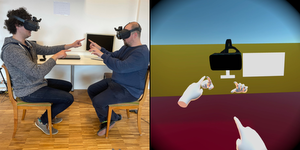Information
- Publication Type: Journal Paper (without talk)
- Workgroup(s)/Project(s):
- Date: April 2021
- DOI: 10.3390/computers10050058
- ISSN: 2073-431X
- Journal: Computers
- Number: 5
- Open Access: yes
- Volume: 10
- Pages: 1 – 17
- Keywords: colocation, multi-user VR, hand tracking , shared space
Abstract
In colocated multi-user Virtual Reality applications, relative user positions in the virtual environment need to match their relative positions in the physical tracking space. A mismatch between virtual and real relative user positions might lead to harmful events such as physical user collisions. This paper examines three calibration methods that enable colocated Virtual Reality scenarios for SLAM-tracked head-mounted displays without the need for an external tracking system. Two of these methods—fixed-point calibration and marked-based calibration—have been described in previous research; the third method that uses hand tracking capabilities of head-mounted displays is novel. We evaluated the accuracy of these three methods in an experimental procedure with two colocated Oculus Quest devices. The results of the evaluation show that our novel hand tracking-based calibration method provides better accuracy and consistency while at the same time being easy to execute. The paper further discusses the potential of all evaluated calibration methods.Additional Files and Images
Weblinks
- https://www.mdpi.com/2073-431X/10/5/58
- Entry in reposiTUm (TU Wien Publication Database)
- Entry in the publication database of TU-Wien
- DOI: 10.3390/computers10050058
BibTeX
@article{reimer-2021-CVR,
title = "Colocation for SLAM-Tracked VR Headsets with Hand Tracking",
author = "Dennis Reimer and Iana Podkosova and Daniel Scherzer and
Hannes Kaufmann",
year = "2021",
abstract = "In colocated multi-user Virtual Reality applications,
relative user positions in the virtual environment need to
match their relative positions in the physical tracking
space. A mismatch between virtual and real relative user
positions might lead to harmful events such as physical user
collisions. This paper examines three calibration methods
that enable colocated Virtual Reality scenarios for
SLAM-tracked head-mounted displays without the need for an
external tracking system. Two of these methods—fixed-point
calibration and marked-based calibration—have been
described in previous research; the third method that uses
hand tracking capabilities of head-mounted displays is
novel. We evaluated the accuracy of these three methods in
an experimental procedure with two colocated Oculus Quest
devices. The results of the evaluation show that our novel
hand tracking-based calibration method provides better
accuracy and consistency while at the same time being easy
to execute. The paper further discusses the potential of all
evaluated calibration methods. ",
month = apr,
doi = "10.3390/computers10050058",
issn = "2073-431X",
journal = "Computers",
number = "5",
volume = "10",
pages = "1--17",
keywords = " colocation, multi-user VR, hand tracking , shared space",
URL = "https://www.cg.tuwien.ac.at/research/publications/2021/reimer-2021-CVR/",
}


